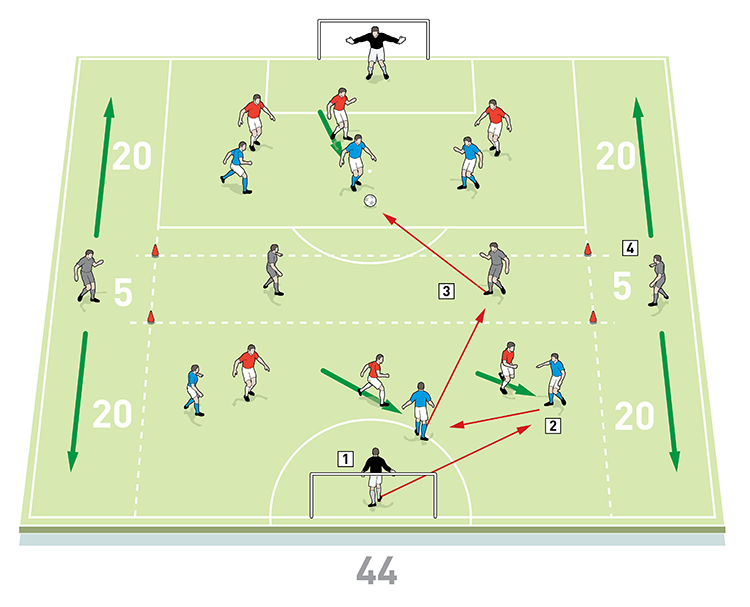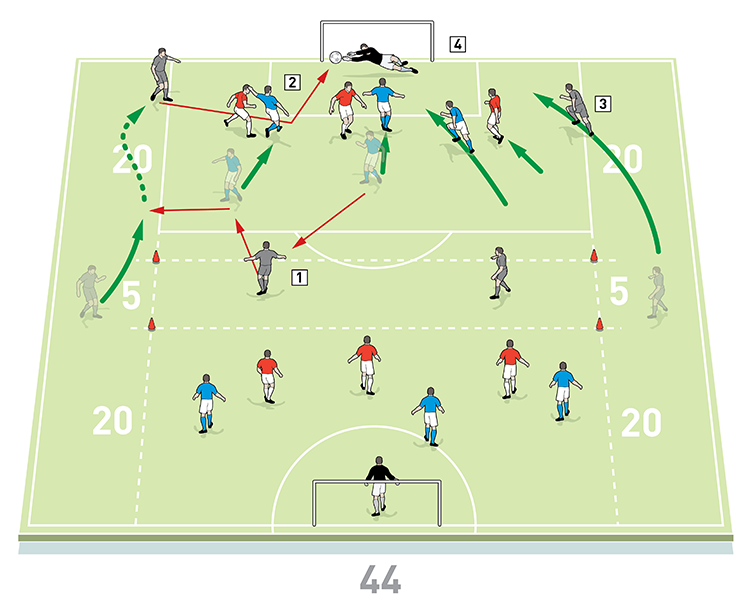You are viewing 1 of your 1 free articles
Forward play in 3-4-3
Creating and linking forward play in the attacking third of the pitch is often the decisive factor in winning games. Creating the link up play is essential, as are receiving skills and movement, and all three can be rehearsed using this session.
| Area | Up to full pitch |
| Equipment | Balls, bibs, cones, 2 full size goals |
| No. of Players | Up to 20 players + 2 goalkeepers |
| Session Time | Total time: 57mins, Warm-up: 15mins, Possession boxes: 12mins, Small-sided game: 12mins, 11v11 game: 18mins |
The session is about working on the front three players in a 3-4-3 formation. It creates 1v1 situations, and shows players how to deal with the ball in tight areas, particularly helping the combination play and link-up play in the final third.
Creating and linking forward play in the attacking third of the pitch is often the decisive factor in winning games. Creating the link up play is essential, as are receiving skills and movement, and all three can be rehearsed using this session.
You can also use the 1v1 aspect of the session defensively – although this is primarily a practice for forwards, it is also a good work out for defenders too as they have to cope with 1v1 situations a lot in this session.
The midfielders who link up play also need to continue to work to find space and their passing options are vital. When the wide players are added in the second part of the session, this replicates the 3-4-3 system and encourages the wing backs to be positive in their delivery and support.
I would usually use this training session at least once or twice a week when playing with three up front. When flipping it over into a defensive session we can then concentrate on the 1v1 defending aspect of the system in the final third of the pitch.
What do I get the players to do?
Possession boxes
Start with a 15-minute warm-up (not shown). Then set up an area consisting of two 15x15-yard boxes separated by a five-yard middle zone. Start with 16 players and split your players into two teams of six, and four neutral midfielders who play for the team in possession. Each of the boxes is 3v3, while two of the midfielders operate in the middle zone and the other two are positioned one at each end of the playing area, as shown [1].
1

2. The midfielders must be able to receive in a tight area and move the ball to a player in the other box or back to the original box
3. You can progress this by pitting the two midfielders against each other so one has to move the ball on under pressure from the other
Start the session by playing a 3v3 in one of the boxes. Once three passes have been made, the team in possession can then play through to the other box via one of the two midfielders in the middle zone. The midfielder who receives the pass can choose to play the ball into either box.
This practice helps players improve their receiving skills in tight areas. We allow the end men to play the ball directly to the midfielder in the middle zone to improve the defensive responsibilities of the front three as well, encouraging them to act as first line of defence. The constant theme of the game is to play away from the press.
Play six two-minute games, changing the neutrals each time.
How do I progress the session?
You can make the two midfielders play against each other so they can’t always just turn and pass into the next box unopposed. They must work on angles and receiving skills and may have to go back to the original box while under pressure from the other midfielder. Whichever one wins the ball plays it through into the other box. Again, this battle in a tight space helps the three strikers work on movement in tight areas and develops their link up play. You can also lift the pass restriction before the ball is transferred to the next box in order to encourage better decision making about when to play forward and away from the press.
What do I get the players to do next?
Small-sided game
Next we take the principle we’ve just worked on into a larger space. On one half of a pitch, set up two areas of 20x44 yards separated by a five-yard midfield zone. We add two full size goals with a goalkeeper at each end. The two teams of six are again playing a 3v3 in each of the two main areas, as shown [2a], but this time play is directional. Again, two neutral midfielders operate in the middle zone but we also add a neutral wing back to each side of the area, allowing them to operate along the edge of the marked out area, cutting in where necessary to support play. The wing backs play for the team in possession and can go in both directions, creating a 3-4-3 shape for both teams.
2a

2. The blues pass under pressure until they can create an opening to play the ball to one of the neutral midfielders
3. The midfielder who receives the pass can play the ball either forwards or back. He plays for the team in possession
4. The wing backs also play for the team in possession and can go in both directions, creating a 3-4-3 shape for both teams
This time the players don’t have to hit a target number of passes before playing the ball through to the middle zone. The midfielders can play the ball in either direction after receiving a pass, but they cannot play it straight out to the wing backs.
As the ball is constantly being transferred through the midfield, numerous 1v1 situations will be created. Clever link up play is encouraged and shots should be constant.
With the wing backs added to the game, an additional dimension of the session is the delivery of the ball into the goalmouth area and the runs of the three forward players, as well as the opposite wing back cutting in and making a run to the back post, as shown [2b].
2b

2. The three forwards make well-timed runs to meet a ball played into the box by the wing back
3. The opposite wing back should be encouraged to make a run towards the back post
4. When play restarts, the blue forwards must be alert to regaining possession high up the pitch, as they are the first line of defence
It is also important to make the three forward players aware that they are the first line of defence when the ball goes dead or when play restarts from the goalkeeper, and they must try and stop the ball from going into the middle zone too easily. This creates realistic situations and makes the link-up midfielders work for space a lot more.
Play four games of three minutes.
What are the key things to look out for?
Look for your players working on their ability to receive in tight areas and their combination play in and around the box. Although this is an attacking session, the defenders and midfielders are key to it working. The spatial awareness of the midfielders and their passing options are very important, as are how the defenders fare in 1v1 situations and their communication with one another.
The focus of the session can be flipped to concentrating on other areas of the 3-4-3 shape, such as the wing backs or midfield options and support.
What are the typical mistakes that players might make?
Beware of all three strikers making the same movement and constantly coming towards the ball. Another problem is forwards not getting shots away quick enough in 1v1 situations. Also, look for forwards not replicating game conditions – make sure they know they are the first line of defence after losing possession or from restarts.
How would you put this into a game situation?
Take this into an 11v11 situation on a full pitch and retain all the basic principles of the session, including creating 1v1 situations and encouraging movement, good receiving skills and link up play. Play three sets of six minutes.
Related Files
Editor's Picks
Intensive boxes drill with goals
Penetrating the final third
Creating and finishing
My philosophy
Pressing initiation
Compact team movement
Defensive organisation
Back three tactics
Counter-pressing as an offensive weapon
Coaches' Testimonials

Alan Pardew

Arsène Wenger

Brendan Rodgers

Carlos Carvalhal

José Mourinho

Jürgen Klopp

Pep Guardiola

Roy Hodgson

Sir Alex Ferguson

Steven Gerrard
Coaches' Testimonials

Gerald Kearney, Downtown Las Vegas Soccer Club

Paul Butler, Florida, USA

Rick Shields, Springboro, USA

Tony Green, Pierrefonds Titans, Quebec, Canada
Join the world's leading coaches and managers and discover for yourself one of the best kept secrets in coaching. No other training tool on the planet is written or read by the calibre of names you’ll find in Elite Soccer.
In a recent survey 92% of subscribers said Elite Soccer makes them more confident, 89% said it makes them a more effective coach and 91% said it makes them more inspired.
Get Monthly Inspiration
All the latest techniques and approaches
Since 2010 Elite Soccer has given subscribers exclusive insight into the training ground practices of the world’s best coaches. Published in partnership with the League Managers Association we have unparalleled access to the leading lights in the English leagues, as well as a host of international managers.
Elite Soccer exclusively features sessions written by the coaches themselves. There are no observed sessions and no sessions “in the style of”, just first-hand advice delivered direct to you from the coach.








